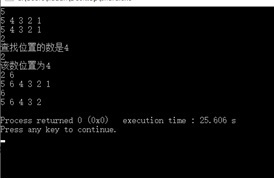6-1 顺序表的实现
作者:互联网

函数接口定义:
顺序表描述的结构体为
typedef struct {
ElemType *elem; //存储空间的基地址
int length; //当前长度
} SqList;
需要实现函数的接口分别为:
int GetElem(SqList L, int i, ElemType &e) 顺序表的取值
判断i值是否合理,若不合理,返回0;[i-1]单元存储第i个数据元素; 返回1
int LocateElem_Sq(SqList L, double e) 顺序表的查找
查找成功,返回序号i+1;查找失败,返回0
int ListInsert_Sq(SqList &L, int i, ElemType e)顺序表的插入
判断i值,不合法返回0;当前存储空间已满,返回0;插入位置及之后的元素后移;将新元素e放入第i个位置;表长增1;返回1
int ListDelete_Sq(SqList &L, int i)顺序表的删除
判断i值,不合法返回0;被删除元素之后的元素前移;表长减1;返回1
void ListInput(SqList &L)顺序表数据的输入
输入顺序表长度;依次输入数据;表长赋值
void ListOutput(SqList L)顺序表数据的输出裁判测试程序样例:
#include<iostream>
#include<string>
#include<iomanip>
#include <cstdlib>
using namespace std;
#define OVERFLOW -2
typedef int ElemType; //ElemType 为可定义的数据类型,此设为int类型
#define MAXSIZE 100 //顺序表可能达到的最大长度
typedef struct {
ElemType *elem; //存储空间的基地址
int length; //当前长度
} SqList;
void InitList_Sq(SqList &L) { //算法2.1 顺序表的初始化
//构造一个空的顺序表L
L.elem = new ElemType[MAXSIZE]; //为顺序表分配一个大小为MAXSIZE的数组空间
if (!L.elem)
exit(OVERFLOW); //存储分配失败退出
L.length = 0; //空表长度为0
}
/* 请在这里填写答案 */
int main() {
SqList L;
int i = 0, temp, a, c;
double price;
ElemType e;
//初始化线性表
InitList_Sq(L);
//输入线性表
ListInput(L);
//输出线性表
ListOutput(L);
//顺序表取值
cin>>i;
temp = GetElem(L, i, e);
if (temp != 0) {
cout <<"查找位置的数是"<<e<< endl;
} else
cout << "查找失败!位置超出范围\n";
//顺序表查找
cin >> price;
temp = LocateElem_Sq(L, price);
if (temp != 0) {
cout << "该数位置为" << temp << endl;
} else
cout << "查找失败!\n";
//顺序表的插入
cin >> a;
cin >> e; //输入a和e,a代表插入的位置,e代表插入的数值
if (ListInsert_Sq(L, a, e))
ListOutput(L);
else
cout << "插入失败\n";
//顺序表的删除
cin >> c;
if (ListDelete_Sq(L, c))
ListOutput(L);
else
cout << "删除失败\n";
return 0;
}
输入样例:
在这里给出一组输入。例如:
5
5 4 3 2 1
2
2
2 6
6输出样例:
在这里给出相应的输出。例如:
5 4 3 2 1
查找位置的数是4
该数位置为4
5 6 4 3 2 1
5 6 4 3 2 int GetElem(SqList L, int i, ElemType &e) // 顺序表的取值
{
if(i<1||i>L.length)//i值不合理的情况
return 0;//不合理返回0
e=L.elem[i-1];//elem第[i-1]单元存储第i个元素
return 1;
}
int LocateElem_Sq(SqList L, double e) //顺序表的查找
{
int i;
for(i=0;i<L.length;i++)//for循环对于顺序表进行遍历
if(L.elem[i]==e) return i+1;//序号i+1
return 0;
}
int ListInsert_Sq(SqList &L, int i, ElemType e)//顺序表的插入
{
int j;
if(i<1||i>L.length)//i值不合法
{return 0;}
if(L.length==MAXSIZE)//存储空间已满
{ return 0;}
for(j=L.length-1;j>=i-1;j--){
L.elem[j+1]=L.elem[j];//将插入位置及之后的元素后移
}
L.elem[i-1]=e;
++L.length;
return 1;
}
int ListDelete_Sq(SqList &L, int i)//顺序表的删除
//判断i值,不合法返回0;被删除元素之后的元素前移;表长减1;返回1
{
int j;
if(i<1||i>L.length)//i值不合法
return 0;
for(j=i;j<L.length;j++){
L.elem[j-1]=L.elem[j];//被删除元素之后的元素前移
}
--L.length;
return 1;
}
void ListInput(SqList &L)//顺序表数据的输入
//输入顺序表长度;依次输入数据;表长赋值
{
int n;
cin>>n;
for(int i=0;i<n;i++){
scanf("%d", &L.elem[i]);
L.length++;
}
}
void ListOutput(SqList L)//顺序表数据的输出
{
int i;
for (i = 0; i < L.length; i++)
{
cout << L.elem[i] << " ";
}
cout<<endl;
}
标签:顺序,实现,Sq,elem,int,length,SqList 来源: https://www.cnblogs.com/15132949hao/p/15664847.html